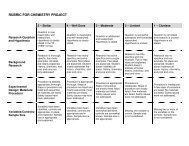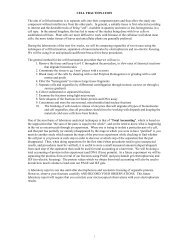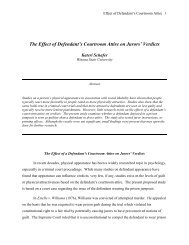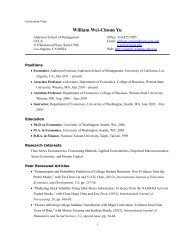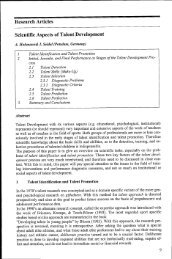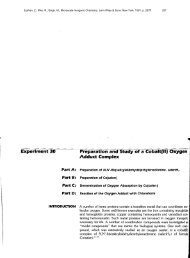Physics 202 Homework, Day 03: Chapter 11 : 38, 41, 44, 46, 47
Physics 202 Homework, Day 03: Chapter 11 : 38, 41, 44, 46, 47
Physics 202 Homework, Day 03: Chapter 11 : 38, 41, 44, 46, 47
Create successful ePaper yourself
Turn your PDF publications into a flip-book with our unique Google optimized e-Paper software.
<strong>Physics</strong> <strong>202</strong> <strong>Homework</strong>, <strong>Day</strong> <strong>03</strong>: <strong>Chapter</strong> <strong>11</strong> : <strong>38</strong>, <strong>41</strong>, <strong>44</strong>, <strong>46</strong>, <strong>47</strong><br />
ü <strong>38</strong>. A glass windowpane in a home is 0.62 cm thick and has dimensions of 1.0m x 2.0 m. On a certain day,<br />
the indoor temperature is 25°C and the outside temperature is 0°C.<br />
(a) What is the rate of heat flow through the glass?<br />
(b) How much energy is lost through the window in one day, assuming the inside and outside<br />
temperatures remain constant ?<br />
In[13]:=<br />
Dx = .0062; k = 0.84; DT = 25 - 0; WindowArea = 2.0; HeatLossPerSecond = k * WindowArea * DT<br />
Dx ;<br />
Print@"The heat loss per second is ", HeatLossPerSecond, " Joules."D<br />
The heat loss per second is 6774.19 Joules.<br />
In[15]:=<br />
Print@" The heat loss per day is ", HeatLossPerSecond * 24 * 60 * 60, " Joules."D<br />
The heat loss per day is 5.8529 µ 10 8<br />
Joules.<br />
ü <strong>41</strong>. A steam pipe is covered with 1.50 cm thick insulating material of thermal conductivity 0.200 cal/(cm °C<br />
s). How much energy is lost every second when the steam is at 200°C, and the surrounding air is at<br />
20.0°C? The pipe has a circumference of 800 cm and a length of 50.0m. Neglect losses though the ends of<br />
the pipe.<br />
The units for this problem are calories, centimeters and °C. Since k is given in these units, we will use thickness in cm, and<br />
area in cm 2 , giving an answer in calories. Multiplying this number by 4.186 will give the answer in Joules.<br />
In[43]:= Dx = 1.50; k = 0.20; DT = 200 - 20; PipeArea = 800. * H50 * 100L;<br />
HeatLossPerSecond = k * PipeArea * DT<br />
Dx ;<br />
Print@" The heat loss per second is ", HeatLossPerSecond,<br />
" calories, or ", HeatLossPerSecond * 4.186, " Joules."D<br />
The heat loss per second is 9.6 µ 10 7 calories, or 4.01856 µ 10 8 Joules.<br />
Note: This seems like a *huge* loss of energy, so I checked it and found that the insulating material chosen is *terrible* - it<br />
has the same thermal conductivity as iron! A good insulator, equivalent to the insulating power of styrofoam, would give an<br />
answer about 1200 times less, or about 3.5 x 10 5 Watts - 345 kW, instead of 402 MW. 400MW is comparable to the output<br />
power of an entire electrical power plant! Sounds like time for another note to the author...<br />
ü <strong>44</strong>. A thermopane window consists of two glass panes, each 0.50 cm thick, with a 1.0-cm-thick sealed<br />
layer of air in between. If the inside surface temperature is 23.0 °C, and the outside surface temperature is<br />
0.0°C, determine the rate of energy transfer though 1.0 m 2 of the window. Compare your answer with the<br />
rate of energy transfer though 1.0 m 2 of a single 1.0-cm-thick pane of glass.<br />
In[88]:= DxGlass = .0050; kGlass = 0.84; DxAir = .010; kAir = 0.0234; DT = 23 - 0; WindowArea = 1.0;<br />
HeatLossPerSecond =<br />
J DxGlass<br />
kGlass<br />
WindowArea * DT<br />
+ DxAir<br />
kAir<br />
;<br />
+ DxGlass N kGlass<br />
Print@"Heat loss per second through Thermopane glass = ", HeatLossPerSecond, " Watts."D<br />
HeatLossPerSecond1 =<br />
WindowArea * DT<br />
J DxGlass<br />
kGlass<br />
;<br />
+ DxGlass N kGlass<br />
Print@"Heat loss per second through double-thick glass = ", HeatLossPerSecond1, " Watts."D
2 <strong>Day</strong>_<strong>03</strong>_sol.nb<br />
Heat loss per second through Thermopane glass = 52.3614 Watts.<br />
Heat loss per second through double-thick glass = 1932. Watts.<br />
That is a *huge* difference - 37 times more heat loss without the layer of air in between.<br />
ü <strong>46</strong>. A Styrofoam box has a surface area of 0.80 m 2 and a wall thickness of 2.0 cm. The temperature of the<br />
inner surface is 5.0°C, and the outside temparature is 25°C. If it takes 8.0 hours for 5.0 kg of ice to melt in<br />
the container, determine the thermal conductivity, k, of the Styrofoam.<br />
Q/sec = k A DT/Dx => k = (Q/sec) Dx / (A DT)<br />
In[34]:= BoxArea = .80; Dx = .020; DT = 25 - 5;<br />
HeatToMeltIce = 5.0 * 3.33 * 10 5 ;<br />
HeatFlowPerSecond = HeatToMeltIce ê H8 * 60 * 60L;<br />
Print@"Rate of fheat flow = ", HeatFlowPerSecond, " Watts"D<br />
kStyrofoam = HeatFlowPerSecond * Dx ê HBoxArea * DTL;<br />
Print@"Thermal conductivity of Styrofoam = ", kStyrofoam, " Jês m °C"D<br />
Rate of fheat flow = 57.8125 Watts<br />
Thermal conductivity of Styrofoam = 0.0722656 Jês m °C<br />
ü <strong>47</strong>. A sphere that is a perfect blackbody radiator has a radius of 0.060m and is at 200°C in a room where<br />
the temperature is 22°C. Calculate the net rate at which the sphere radiates energy. [In other words, the<br />
difference between the radiation it gives off at 200°C and what it receives from the surroundings at 22°C.<br />
And... remember to use Kelvins!]<br />
In[75]:= s = 5.67 * 10 -8 ; Tradiator = 200 + 273.15; Troom = 20 + 273.15; sphereArea = 4 p .060 2 ;<br />
NetHeatFlow = s * sphereArea * Tradiator 4 - s * sphereArea * Troom 4 ;<br />
Print@"The net heat flowing out of the sphere is ", NetHeatFlow, " Watts."D<br />
PrintA"The heat flowing out of the sphere is ", s * sphereArea * Tradiator 4 , " Watts."E<br />
PrintA"The heat flowing back from the room is ", s * sphereArea * Troom 4 , " Watts."E<br />
The net heat flowing out of the sphere is 109.612 Watts.<br />
The heat flowing out of the sphere is 128.556 Watts.<br />
The heat flowing back from the room is 18.9433 Watts.






